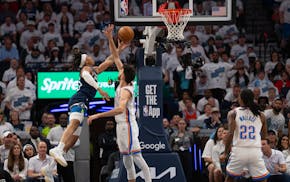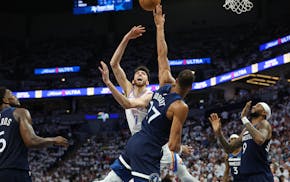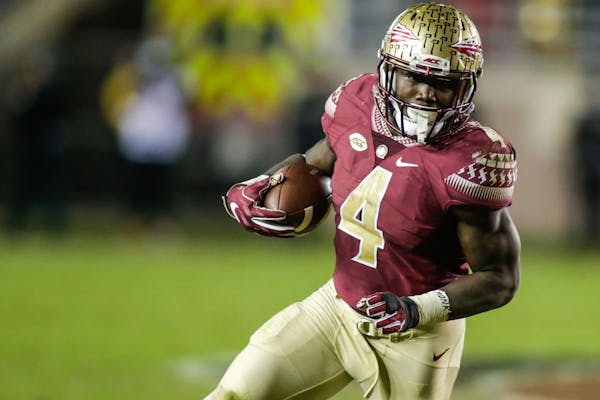The Vikings used their first two draft picks to select offensive players, causing some to wonder if coach Mike Zimmer paced the room in an agitated state like a caged animal.
Zimmer eats, breathes and sleeps defense. He's also not known for his patience. But, no, he didn't put General Manager Rick Spielman in a headlock and refuse to let go until he promised to take a defensive player.
"He was fine," Spielman said. "Because he wants to score points, too."
Fine? Zimmer probably wanted to do cartwheels over those moves because fixing the Vikings feeble running game should be priority No. 1 this offseason. Their first two picks — running back Dalvin Cook and center Pat Elflein — will help that process.
The Vikings were the worst rushing team in the NFL last season, finishing last in average yards per game (75.3) and yards per carry (3.2).
For context, they were historically inept, statistically the worst rushing offense in team history. Chew on that for a moment. No previous Vikings offense ran the ball as ineffectively as the 2016 outfit, which routinely made defenses look like the '85 Bears.
The Vikings ranked 25th in the NFL last season when they ran the ball on third-and-2 or less, according to ESPN Stats and Information. They converted only 59.1 percent in those situations.
The result was Zimmer's defense finished the season on fumes. The defense wore down largely because of the offense's failures, particularly on the ground.
"A lot of times when you go three-and-out offensively and there's three passes, that's a quick possession," Zimmer said. "This adds to the way we want to play the game."
The NFL undeniably has changed. It's become a quarterback-driven league, reducing the value of running backs and reliance on the running game. A run-dominated philosophy has gone the way of vinyl records and dial-up Internet. Only three teams averaged 30-plus carries this season. Ten years ago, 10 teams averaged at least 30.
Conversely, only four teams attempted fewer than 500 passes this season. In 2006, 12 teams didn't throw 500 passes.
The evolution puts a higher premium on quarterback play, but that doesn't render a running game meaningless. The Dallas Cowboys, Atlanta Falcons and New England Patriots finished in the top seven in rushing last season, so good teams still find value in running the ball.
Balance is key, or at the very least, establishing enough of a threat to prevent becoming predictable.
"It's hard to play-action pass if you can't run the football," Zimmer said. "The defensive line kind of lays their ears back. They play a lot more coverage. So it makes it much more difficult, not only on the offensive line but on the quarterback and receivers as well."
Zimmer clings to old-school principles. Run the ball, play solid defense, control the clock. That formula can be successful as long as the quarterback also plays at a high level. It doesn't have to be an either-or choice.
The Vikings no longer should feel constrained by an outdated template of relying on a bell-cow running back. Adrian Peterson reached 250 carries six times in his decade with the team, which included two seasons that he essentially missed because of suspension or injury.
A committee approach with Cook, Jerick McKinnon and free-agent pickup Latavius Murray should make the offense less predictable under coordinator Pat Shurmur.
Blocking for them should be better, which isn't a high bar to clear because the offensive line can't perform any worse than its 2016 stench.
"I know Coach Zim wants to run the ball," Spielman said.
That option basically disappeared last season, a futile exercise that gnawed at Zimmer. He vowed to fix it, making it no coincidence that the Vikings used their top two picks on a dynamic running back and hard-nosed center.
The defensive head coach loved the plan.
"I'm just trying to win," he said. "I don't really want it to be 65-63, but I just want to win games. So however we do it, I don't really care."
Chip Scoggins chip.scoggins@startribune.com

Scoggins: Buckle up Wolves fans, it's going to be a very telling offseason

Scoggins: Finch's next challenge is to unleash the Wolves' youngsters

Scoggins: Timberwolves learn just how far behind they are

Scoggins: Chet Holmgren is in the right place at the right time


